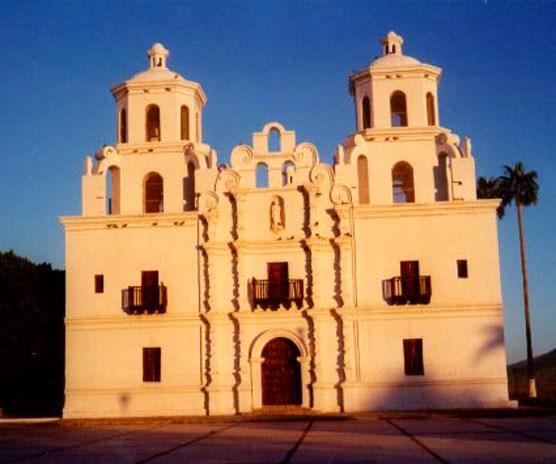
The first church at Caborca was built soon after October 1694 when Jesuit missionary Francisco Xavier Saeta became its first priest. Father Saeta was martyred in an O'odham uprising in April 1695, and two months later both his house and the church were burned. In 1698 repairs were made on the buildings, and between 1702 and 1706 a replacement church was constructed with the help of carpenters brought to the site by Father Kino. By 1730, however, it had apparently fallen into ruin because Caborca, then a visita of Tubutama, was said to be without a proper place of worship. "It appears that sometime between 1743 and 1749 a third church was completed at Caborca, one also destined to be heavily damaged - if not destroyed - in 1751 during the Pima uprising when Caborca's resident missionary, Tomás Tello, was killed by the O'odham. When Father Juan Díaz took over for the Franciscans in 1768, he described the Jesuit construction at Caborca as a partially destroyed building of adobe with a roof of straw and dirt. It was nonetheless the cabecera with visitas at San Diego del Pitiquito and Santa María del Pópulo - earlier San Valentín de Bísanig." (The Pimeria Alta: Southwest Mission Research Center) Bishop Antonio de los Reyes on 6 July 1772 wrote a report on the condition of the missions in the Upper and Lower Pimería Alta. Following is his report on La Purísma Concepción de Nuestra Señora de Caborca as translated by Father Kieran McCarty: The Mission at Caborca with two outlying mission stations is located in the westernmost territory of Upper Pimeria, eight leagues from the above mentioned Mission at Ati and sixteen leagues from the Gulf of California. To the south is the uninhabited territory of Lower Pimeria, and to the north the settlements of the Papagos and the other pagan nations of the Gila and Colorado Rivers at a distance of sixty to seventy leagues from this Mission. The village at Caborca is situated in open country, quite exposed to floods, due to the risings of an arroyo which flows with great volume during the rainy season. During the recent year of 1771 the Missionary Father was in favor of moving the village to a higher and more secure area nearby. The lands and climate at this Mission are very favorable for the farming and cultivation of cotton. The Indians communally plant wheat, Indian corn, and other crops and work a few fields individually. The house of the Missionary is decent and has sufficient office space. Adjoining it is a garden with quinces, pomegranates, peaches, lemons, oranges, and a vineyard of good grapes, but they do not make wine although by depriving themselves of the pleasure of eating the grapes, they could make two or three small barrels of it. The church is adorned on the inside with a side chapel and paintings in gilded frames. In the sacristy are two chalices, a dish and cruets, and baptismal shell, all of silver. They have sufficient vestments and other poor adornments for the altar and divine services. According to the Census Book, which I have here before me, there are one hundred thirty-three married couples, seventeen widowers, twenty-six widows, eight orphans, the number of souls in all six hundred thirty-four. "Father Barbastro wrote in 1788 that by 1783 the temple at Caborca had been beautified, suggesting some Franciscan improvements on a Jesuit edifice. In 1792, he observed optimistically that Father José Mora, a man of 'little schooling, but very efficient,' was following his order to begin a new stone and mortar house of worship at Caborca. "As it turned out, Father Mora left Caborca in 1793. When Father Yturralde made his visit in 1797, the old building with a sacristy with adobe walls and a flat wood-beamed roof was still there, although the floor was tiled. "It was Father Andrés Sánchez who started the present structure no earlier than 1803 if a report written that year by Father Francisco Mayano can be credited. It was finished by May of 1809 under the successive administrations of Fray Santiago Usuastegui and Fray Saturnino Arizeta." The Caborca mission is located at a bend of the Río Concepción. Unfortunately this was one mission that was not located high enough above the river so it has sustained substantial flood damage over the years. "General deterioration and damage from floods began to eat away at the rear of the church and its northerly convento wing beginning in 1890 when a room collapsed. A large room fell in 1899, and in 1915 the back of the convento and two more rooms closer to the main altar were ravaged. The sanctuary with its main altar was taken out in 1917. Restoration began in 1957, ...but in January 1993 a flooding Río Concepción destroyed the rebuilt convento and most of the rebuilt north sacristy." (The Pimeria Alta: Southwest Mission Research Center) |
Last updated: May 6, 2025
